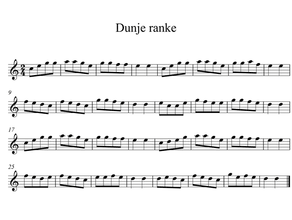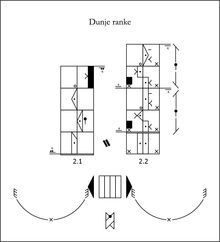DUNJE RANKE
Dunje ranke is the favorite dance of the elderly. It consists of a Kolo for men and women (the first part) and a couple dance (second part). In the first part, the dancers step to the left and right in a closed circle while joining with the Kolo hold. For the second part of the tune, the men make a half turn with the woman on their right to the right and a half to the left, returning to the beginning position of the closed circle. They use the Tanac hold when turning (the woman’s hands are on the shoulder of the man; the man’s hands are on the woman’s waist).
Today there is a circle dance with a similar melody and of the same name performed in Serbia and the northern parts of Croatia (Dunje ranke, Duneranka). The Serbs in Hungary know it as a circle dance, too. However, the Bosnian Dunje ranke is slower, sometimes accompanied by polyphonic singing, a dance half-way between the Kolo and Tanac for the music of a piper. The persons who described it from Áta, Pogány, Szalánta, all categorized it as a very old dance, of their grandparents’ time (referring to the 1880s). Therefore, it cannot be grouped as a newly ‘taken-over’ one (unlike the other Serb origin ones, which spread among the Hungarian Serbs and Croats after the occupation of Southern Region by the Serbs from the beginning of the 1920s.) The dance structure itself is a rarity (the first part: closed circle, the second part: partner dance). A Serbian dance called Srpkinja has a similar structure, but it is for well-known musicians’ music and choreography (I. Bajić and N. Vulko Varadanin) from 1902. (Bartók Béla recorded the music of Srpkinja as folk-dance music by phonograph in Temesmonostor in 1902, though its author was a fellow student of his at the Music Academy in Budapest…)
If we search for similarities, we find the wedding dances of the Croats by the river Dráva. There the prescribed Kolo form is broken by the two Kolo leaders taking the bride (or another woman) from the line into the middle of the circle dancing a partner dance with her there. Dunje ranke danced by the Bosnians represents the transformation period from Kolo to the partner dance; we suppose there was a similar process in the case of Tanac as well.
MUSIC
VIDEO




